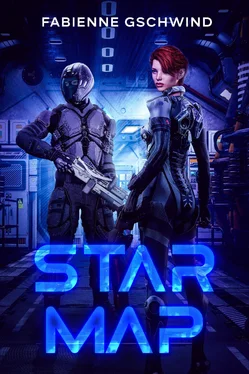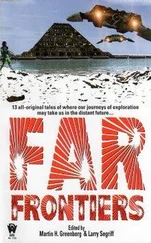In the stern of the ship—or where there should have been stern in a sane ship—was the fission reactor, which provided power for the ship. Should it fail, there was a second reactor amidships and, in an emergency, a fusion drive in the bow. Below the fusion drive was a hangar with two shuttles. These were to serve as emergency shelters or to approach a comet and collect water or hydrogen if needed.
The crew quarters were partly on deck 5.5 and partly on deck 3, averaging about deck 4. The living and working areas were therefore simply called deck 4.
The Abhysal was originally designed for 15 crew members. When the ship was designed, it was thought that a group of subspace scientists would accompany the flight, but that had not happened. The quarters were scattered all over the deck, so everyone had to walk about the same distance to get to the lounge with a combined kitchen. The quarters were nothing more than prefabricated containers that contained the furnishings of a luxury hotel. Each quarter had a bedroom with a large bed. A bathroom with a toilet and shower, and an office/living area. In advance, everyone had had time to furnish their cabin to their taste.
The vacant quarter had been converted into studios, music rooms, and other facilities, as mentioned above. Nevertheless, there were still five quarters available. The salon and kitchen were also designed for 15 people and there was plenty of room. On the same deck was the bridge—Jay's office—and the astrolab with the attached AI room. Lex, Milo, and Jay theoretically didn't have to leave Deck 4 to work. Only Nemo and Joe had their workstation in the combined engine room.
The Abhysal itself was a pure subspace ship. It did have a sublight drive to maneuver into a hangar if needed or to avoid a speeding planet, but that was all it had. But it certainly wasn't meant to run sublight races. In normal space, the Abhysal was as maneuverable as a sperm whale on a beach.
The dive generator that submerged the Abhysal into subspace was relatively small. So small, in fact, that most visitors didn't even notice it. It even happened that visitors mistook the large hot water boiler for the dive generator, and the dive generator was more often mistaken for the washing machine because that's what it looked like. The subspace distortion was channeled through the crooked fins in space, where it opened the subspace fissure.
The advantage was that the Abhysal had huge cargo holds that contained many spare parts. For example, several containers were scattered around the ship and contained about 30 dive generators in case one failed.
In any case, the ship was full of spare and replacement parts. "Enough to build the Abhysal from scratch," Joe likes to claim, and Nemo added, "at least three times...."
On the top three decks were 500 radio buoys and 500 carrier pigeons. The radio buoys were the markers that the Abhysal laid out along its path. After 14 years of installing only 120 buoys and sending 98 carrier pigeons, the vacated space was commandeered by Jay.
This was his sparring ground and shooting range. The crew was quite amazed when guns kept showing up hidden on the ship. No one knew exactly how Jay had come by all this war material. Unfortunately, Jay couldn't use his many weapons in the ship itself and had to make do with simulation weapons. But his weapons were his treasure, and he spent a lot of time cleaning and maintaining the rifles and pistols.
The laboratory, sickbay, and workshop also took up an entire half-deck and were located on Deck 5 as above the living quarters. Next to Nemo's technology workshop was of course the 3D-printer lab. All possible 3D-printers were available to the crew and every imaginable part could be created. Of course, there were also containers of raw materials available to feed the 3D-Printers.
It was January, a Sunday afternoon to be exact, the crew worked every day, but today was declared a holiday. The previous week they had set a new record: They had traveled 1800 light-years in a week, three times faster than anything possible before. A pond was responsible for this. Ponds were subspace formations where it was completely peaceful and there was no danger. They had descended almost to the abyss and caught a favorable wind there. So deep down in the curvature of dimension, the light-years flew by like nothing. Now they had emerged into normal space and had done a full scan to measure the surrounding stars and solar systems.
A lavish Sunday brunch was arranged for the festivities and the cooking robot was programmed accordingly. After brunch, everyone was stuffed and they snuggled into the sofas. Lex had rehearsed a poem and recited it, which sparked a discussion about 22nd-century poetry.
Sunday or not, Jay insisted on daily emergency training. The three biggest dangers in subspace were the monster wave, the vortex and the typhoon.
Monster waves were a kind of pent-up subspace energy that appeared suddenly. One had only short warning times and the survival depended only on the fact that the ship was positioned correctly in the wave to "surf along".
The crew had here the best protection: Jay had “ridden” whole twelfe monster waves and was considered world-wide as the most experienced pilot in this topic. And so the crew played out the monster wave scenario. In their 14 year mission they had already experienced three waves and the danger was real.
With the typhoons, the crew had been lucky and thanks to the extreme sensors, they had been able to detect these "subspace storms" in time and get out of the way. Typhoons were not particularly deadly, but they could cause a ship to drift tens of thousands of light-years in the wrong direction. How many astronavigators had been driven far off their route by typhoons and then simply not made it back was not known. But it was a real danger and in the StarMap contracts it was clearly stated that a return was not guaranteed - in the worst case the crew would have to spend the rest of their lives on an alien planet.
The chance of dying in subspace was very real to them. The StarMap balance was 10%. 10% of ships were lost in subspace. Another reason it was so difficult to recruit people.
The vortex was the most deadly subspace hazard and was the least understood phenomenon. The problem was that you only saw it when you were already in the strong downward currents.
Nemo was the only living person who had survived a vortex experience. "But also, only because we had turned off on time before we were in the maelstrom".
The emergency maneuver that Nemo's then-captain had performed had flung Nemo's old spaceship into a white-water area, from where it had collided violently into a cliff. Nemo had survived because he was wearing his high-end technician suit, which had protected him from the pressure drop. The fact that he was wearing this suit saved his life when the ship’s hull was torn open. Fortunately, they were on their way back, and thanks to the subspace maps they had sent earlier, an ambulance ship reached him in time. He was the only survivor.
Milo took the opportunity to show some sensor data from Vortex-like phenomena that he had recently recorded. It seemed that there might be a particularly large number of vortexes in this area. The general hypothesis was that the ships were pushed into the deep abyss, where they were torn apart by tidal forces. Milo was about to give a lecture on his latest hypothesis, but Jay interrupted him.
The Captain, noting that everyone had loitered enough, took the lead and invited the crew for a Sunday stroll along the long corridor of Deck 8. Using virtual goggles, he had designed a walk that took the crew to the Dolomites, well-planned changes in gravity gave the feeling of going up or down. The evening ended with a poker game, in which Milo won, as always.
Читать дальше












